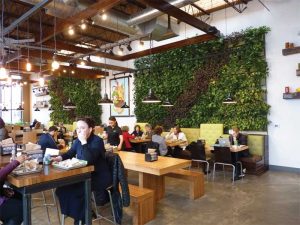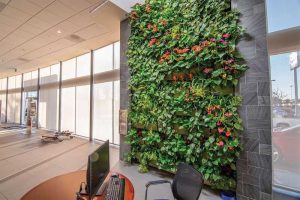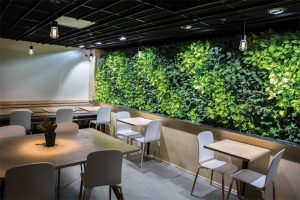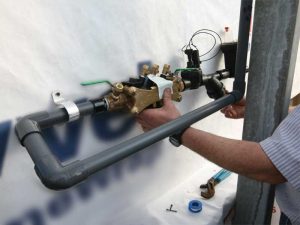Critical success factors for indoor green walls
by sadia_badhon | March 8, 2019 11:02 am
by Amber Ponce, GRP
 [1]
[1]The innate need of human beings to connect with nature is known as biophilia. In order to nurture this vital connection, biophilic design purposefully incorporates natural materials and light, plants, views of the outdoors, and other touchpoints with the outside world into the built environment.
According to the National Human Activity Pattern Survey (NHAPS), Americans, on average, spend 87 percent of their time indoors. This is why the application of biophilic design to indoor environments is important. Greening up the interiors of buildings with plants promotes well-being and offers an array of benefits.
Benefits of plants indoors
Plants bring life to interior spaces and make them more healthy and comfortable. Plants naturally infuse the air with oxygen and reduce carbon dioxide (CO2) and airborne particulates, thereby improving overall air quality. Through the natural process of evapotranspiration, plants can release water vapor, thereby cooling the air in summer and restoring a healthy level of moisture in heated spaces during winter. Therefore, green walls are expected to enhance the effectiveness of the HVAC systems. However, more research is needed to establish the effects of indoor green walls on HVAC system size, design, and operations.
Cornerstone University in Grand Rapids, Michigan, installed green walls over the cool air intakes in their new STEM building. By pulling air through the vegetated canopy, the university and design team expect to harness the natural cleaning and oxygenation effects of green wall plants.
Additionally, plants and soil are acoustic insulators helping dampen and reduce indoor noise. The 2015 study, “Evaluation of green walls as a passive acoustic insulation system for buildings,” by Z. Azkorra, G. Pérez, J. Coma et al. in Applied Acoustics found green walls[2] provided an average sound reduction of 15 dB and a sound absorption coefficient (SAC) of 0.4 (i.e. it absorbed 40 percent of sound).
Greening up the interiors of commercial buildings boosts occupants’ productivity and decreases human resources costs. Integrating plants into workplaces can reduce eyestrain, relieve mental fatigue, diminish stress, enhance creativity, and improve focus. Workplaces with biophilic design elements, such as interior plantscaping, have experienced a reduction in absenteeism, fewer complaints, and improved staff retention. According to a presentation by I. Elzeyadi on “Daylighting-Bias and Biophilia: Quantifying the Impacts of Daylight on Occupants Health” at the 2011 Greenbuild conference in Washington, D.C., employees with views of trees and landscape took an average of 57 hours of sick leave per year, compared to the 68 hours taken by employees without any view.
Including plants in hospitality and retail interiors makes the space more attractive, welcoming, and relaxing for customers. For example, Coava Coffee (Portland) incorporated a green wall into one of its cafes to enliven the atmosphere.
 [3]
[3]Photo courtesy LiveWall and Florasource
“We are offering hospitality and creating a welcoming ambiance so our customers feel like invited friends,” said Matt Higgins, president of Coava Coffee Roasters. “The green wall contributes to that inviting feeling we strive for, and it has been very well received by our customers.”
Using plants in healthcare settings enhances the experience of patients, visitors, and staff, who report positive feelings and greater satisfaction in the presence of natural elements. Patients who can see and experience plants use less medication, and they have reduced recovery times after medical procedures.
For example, MossRehab (Elkins Park, Pennsylvania), the physical and cognitive rehabilitation division of the Einstein Healthcare Network, established the Alice and Herbert Sachs Therapeutic Conservatory to bring the benefits of biophilia to their patients. MossRehab serves patients in need of rehabilitation to overcome the effects of spinal cord injuries, strokes, amputations, traumatic brain injuries, and other accidents and medical conditions. The plant-filled conservatory includes a green wall.
“You can see the difference it makes when patients come into the conservatory, which is richly oxygenated, warm, and moist, and where they are surrounded by green,” said Abby Jaroslow, HTR, CH, horticultural therapist, MossRehab. “They can feel completely removed from the hospital setting. It is relaxing and therapeutic just to be there. With patients experiencing agitation and anxiety, you can see the relief they experience.”
Further, student exposure to nature has been correlated with higher academic performance in both math and English. Studies have also demonstrated connecting to nature eases symptoms of attention deficit hyperactivity disorder[4] (ADHD).
 [5]
[5]Photo courtesy LiveWall and Acheff Images
In examining the relationship between what the researchers called “greenness” and test performance after adjusting for levels of urbanization, income levels, and gender, researchers found spring data particularly compelling. Spring is when children take the Massachusetts Comprehensive Assessment System[6] (MCAS). March outcomes revealed a highly significant association between school performance in both Math and English and surrounding greenness, particularly as the buffer zone widened. Results from July and August suggest children with higher levels of exposure to greenness during the rest of the year show better academic performance.
Why green walls
Also known as living walls, green walls are integrated structural and horticultural systems attached to existing walls to transform them into vertical gardens. Green walls are a good way to achieve the benefits of biophilic design in commercial buildings. There are several reasons why building owners and facility managers find green walls to be a practical and attractive solution for bringing the outdoors indoors.
Living walls may be mounted on nearly any type of interior wall from reinforced concrete to wood framing. Specifiers may need to indicate required spacing, which varies for different types of green wall systems, as well as the type of fastener appropriate for the wall on which a vertical garden is to be mounted. For example, 6 to 44-mm (¼ x 1 ¾-in.) hex washer head screw anchors are specified for brick or poured walls and 4 to 25-mm (0.16 to 1-in.) ballistic head fasteners are appropriate for steel/aluminum studs.
Living wall costs can vary greatly, depending on the size and shape, location and accessibility, plant selection, and local labor rates. In this author’s experience, most commercially installed green walls can cost between $90 and $150 per square foot.
With an eye toward the cost of commercial space per square foot, it makes business sense to place interior plantscapes on walls and thereby conserve valuable floor space for other uses. As most living walls have integrated irrigation, they cost less to care for than individual potted plants and herbs requiring regular hand-watering. Living walls also provide a larger, more prominent, and engaging display of plants than individual potted plants. Plantings at or above eye-level are more noticeable and attract attention from a distance.
Green walls can also be an attractive, organic alternative to a variety of traditional two-dimensional architectural treatments. Enclosing equipment or utilities such as HVAC units with living walls converts the view of unsightly mechanicals into beautiful points of interest.
| REFERENCES |
| 1. Biophilia by Edward O. Wilson, (Harvard University Press, 1984).
2. The Biophilia Hypothesis, Stephen R. Kellert and Edward O. Wilson, ed. (Island Press, 1993). 3. Biophilic Design: The Theory, Science and Practice of Bringing Buildings to Life, Stephen R. Kellert, Judith H. Heerwagen and Martin L. Mador, ed. (John Wiley & Sons, 2008). 4. Janet Dunn’s article, “Biophilic design: How architecture can contribute to a healthier, less-stressful life,” for the Architect (February 21, 2018). 5. “Therapeutic Influences of Plants in Hospital Rooms on Surgical Recovery” by Seong-Hyun Park and Richard H. Mattson (HortScience, 2009). 6. “14 Patterns of Biophilic Design: Improving Health and Well-Being in the Built Environment” by William Browning, Catherine Ryan, and Joseph Clancy, (Terrapin Bright Green, LLC, 2014). |
Ensuring green wall success
Green industry experts, living wall manufacturers, architects, interior designers, and building owners agree the following factors must be addressed for a successful installation.
Goals
Defining goals at the start of the planning process is essential. Goals determine the size and placement of a living wall.
Is the green wall primarily intended for building occupants or visitors? Are specific green wall benefits a priority? For example, if a green wall is intended for the occupants of a commercial building to gain productivity benefits, it will have to be highly visible to the people who work in the building.
Location
The goals for the green wall have a major influence on where it will be installed. However, other factors are also important. This includes plumbing for watering the plants, electricity for lights and irrigation timers, and floor drainage.
System selection
One must select a system that achieves the defined goals and will have predictable maintenance costs. The two important questions to ask are:
- how long are the plants expected to perform in the structure before they need replacement; and
- how simple is plant replacement?
Since tropical plants typical of indoor installations have large root structures, a system with a larger planter size will require less frequent replacements. Plant orientation within planters is as important as size. Green walls should support plants as nature intended with roots growing down and stems and leaves growing up. Additionally, it is advisable to ask potential suppliers about how water is delivered and drained from the plants, the management of soil fertility, and expected maintenance costs.
Design
Lighting is probably one of the most overlooked aspects of green wall design. The light sources commonly used for human comfort in commercial interiors lack sufficient intensity and fall outside of the spectrum required to support healthy plants. It is best to involve the green wall system supplier in the selection of the actual light bulb or source to provide the right spectrum for plants. When it comes to fixtures, ceiling-mounted track lighting is the most flexible method of illuminating a green wall, as it allows for adjusting the angle and spacing to evenly light the surface.
In addition to light spectrum, light intensity (a measure of light energy hitting the plant surface) is a critical factor for plant health. For most tropical foliage plantings, 2153 to 4306 lux (200 to 400 fc) of light energy is sufficient to provide the required nutrition.
 [7]
[7]Photos courtesy LiveWall
Another key aspect that is often overlooked is a plan for Occupational Safety and Health Administration (OSHA)-compliant access for maintenance on taller installations. If a ladder cannot be opened in the space or will not be tall enough to safely reach the upper rows of plants, alternate access must be planned for. In these cases, it can help to consult with suppliers of fall protection equipment for the most appropriate solution for the site. This may include permanently installed fall protection anchors.
Plants
Most importantly, interior green walls need plants that can thrive indoors. Horticultural expertise and green wall experience are important for making good selections. It is critical to select plants with compatible growth habits and water and light needs. One must also avoid placement of trailing plants such as Schindapsus ‘silver satin’ (satin pothos) above upright growers such as Spathiphyllum (peace lily).
Simplicity in plant design leads to more effective displays, usually less is more. Some of the most striking living wall designs have two or three selections arranged in wave or striped patterns. One might consider using different colors of the same type of plant, such as Anthurium (tail flower, flamingo flower) or Sansevieria (snake plant, mother-in-law’s tongue). Random arrangements of five to six upright or billowing selections, such as Philodendrons, Dracaenas, Ficus elastica (rubber fig), and Ficus lyrata (fiddleleaf fig), offer a more naturalistic design. Use smaller plants for more detailed plant designs, but be sure they will grow tall enough, or tail low enough, to cover the green wall system’s structure.
The growing media used to sustain plants on indoor living walls depends on plant selection. The durability of the media should match the life expectancy of the plants. For perennials, vines, and tropicals that are expected to last for three to five years before dividing, a quality potting soil with perlite or pumice and/or composted pine bark is the good choice.
Watering
 [8]
[8]Irrigation schedules depend on a number of factors, such as system design, lighting, and plant types and maturity. As a rule of thumb, plants on the same irrigation zone must have similar water needs. For example, a water-conserving succulent like Crassula ovata (jade plant) should not be paired with a humidity-loving Chamaedorea elegans (parlor palm). It is impossible to water one type of plant properly without over- or under-watering the other.
The method of water delivery and drainage varies by manufacturer. Some systems use drip emitters to irrigate rows of planters and others wick water up from a trough below the planters, while some trickle water down through planted panels.
A well-managed living wall should be watered just to the point of runoff, with minimal waste. Some systems collect runoff water from the living wall planters and direct it to floor drains. Others hold water in planters or recirculate it through the plants and growing medium.
Specifiers may need to exercise caution with green wall systems designed to hold water in the bottom of planters or to recirculate water within the structure. Water stored in the bottom of planters may cause root rot and unpleasant odors. In systems cycling water multiple times, salt buildup with the ability to compromise the long-term health of plants might occur. Further, if a single plant is diseased, a recirculated system may quickly spread the illness to other plants.
Maintenance
Routine maintenance involves checking soil moisture, adjusting irrigation, fertilizing from spring through fall, pruning, cleaning out dead leaves, and trimming to maintain a design. Using leaf shine can provide a dust-resistant gloss and protective barrier. Trailing plants should be trimmed regularly so the runners cover the system planters but do not smother the plants directly below them.
The amount of time and effort it takes to maintain a green wall varies by the size of the installation. One might discuss the maintenance requirements and costs with other building owners and facility managers who have experience with living walls. For large installations, it can be a good idea to get bids from firms specializing in maintenance of office plants. For a 9 to 14-m2 (100 to 150-sf) interior installation, a biweekly schedule of 10 to 20 minutes per visit will suffice.
In conclusion, the owners and facility managers of a wide variety of commercial buildings are enjoying the many benefits of indoor living walls as an element of biophilic design. Attention to critical success factors is the key to achieving these benefits.
Amber Ponce, GRP, is business development manager for LiveRoof Global and LiveWall. Ponce has participated in the development of industry standards for green roofing and living walls. She can be reached at amberp@livewall.com[9].
- [Image]: https://www.constructionspecifier.com/wp-content/uploads/2019/03/LiveWall_Brome-Burger_6.jpg
- green walls: http://ec.europa.eu/environment/integration/research/newsalert/pdf/Green_walls_show_promise_as_sound_barriers_for_buildings_403na3_en.pdf
- [Image]: https://www.constructionspecifier.com/wp-content/uploads/2019/03/Subaru-Pacific_Dearship_LiveWall_4.jpg
- nature eases symptoms of attention deficit hyperactivity disorder: https://www.ncbi.nlm.nih.gov/pmc/articles/PMC1448497/
- [Image]: https://www.constructionspecifier.com/wp-content/uploads/2019/03/Acheff-Images_LWall_Coava-Coffee_1.jpg
- Massachusetts Comprehensive Assessment System: https://journals.plos.org/plosone/article?id=10.1371/journal.pone.0108548
- [Image]: https://www.constructionspecifier.com/wp-content/uploads/2019/03/LWall_Downtown-Market-2.jpg
- [Image]: https://www.constructionspecifier.com/wp-content/uploads/2019/03/Closeup-Irrigation-Mainline-behind-Green-Wall.jpg
- amberp@livewall.com: mailto:amberp@livewall.com
Source URL: https://www.constructionspecifier.com/critical-success-factors-for-indoor-green-walls/